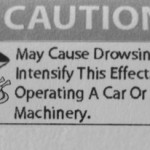False.
 You slowly push yourself away from the table after having just completed your third heaping plate of Thanksgiving dinner. The meal included mashed potatoes, gravy, stuffing, cranberry sauce, three bean salad, homemade bread, pumpkin pie, ice cream, wine, and of course lots of turkey. You slosh your way over to the sofa where you settle in and get comfortable. Your intention is to watch some Thanksgiving Day football. However, even with nearly a dozen kids running crazy through the house rambunctiously reenacting scenes from Star Wars, you drift off to sleep in a matter of minutes. An hour and fifteen minutes later, after getting struck by a misguided light saber strike, you wake up and realize you missed the entire fourth quarter of the game. Of course the blame for drifting off into the dream state is immediately directed at the turkey, which we all know is laced with that evil substance tryptophan. Tryptophan is an amino acid and is a precursor (helps make) serotonin.
You slowly push yourself away from the table after having just completed your third heaping plate of Thanksgiving dinner. The meal included mashed potatoes, gravy, stuffing, cranberry sauce, three bean salad, homemade bread, pumpkin pie, ice cream, wine, and of course lots of turkey. You slosh your way over to the sofa where you settle in and get comfortable. Your intention is to watch some Thanksgiving Day football. However, even with nearly a dozen kids running crazy through the house rambunctiously reenacting scenes from Star Wars, you drift off to sleep in a matter of minutes. An hour and fifteen minutes later, after getting struck by a misguided light saber strike, you wake up and realize you missed the entire fourth quarter of the game. Of course the blame for drifting off into the dream state is immediately directed at the turkey, which we all know is laced with that evil substance tryptophan. Tryptophan is an amino acid and is a precursor (helps make) serotonin.
Serotonin can be converted or turned into melatonin which has been shown to cause sleepiness and drowsiness in humans. Research has shown that giving humans L-tryptophan (Charney et al, 1982) can increase feelings of drowsiness. However, it is widely believed that tryptophan doesn’t act on the brain unless it is consumed on an empty stomach and there is no protein present in the gut (there is lots of protein in turkey). Additionally, there is not enough tryptophan in turkey to cause you to become sleepy. There is also tryptophan in eggs, beans, cheese, beef, pork, lamb, chicken, milk, barley, brown rice, fish, and peanuts, yet none of these foods are credited, or blamed for inducing sleep. Experts agree that one of the reasons we become sleepy after we eat a big meal is blood is diverted from the brain and other parts of the body to the stomach to aid with digestion.
Reference:
Charney D, Heninger G, Reinhard J, Sternberg D, Hafstead K: The effect of intravenous L-tryptophan on prolactin and growth hormone and mood in healthy subjects. Psychopharmacology (1982), Vol 77, pps. 217-222.
